| Please note that these pages are from our old (pre-2010) website; the presentation of these pages may now appear outdated and may not always comply with current accessibility guidelines. |
| Please note that these pages are from our old (pre-2010) website; the presentation of these pages may now appear outdated and may not always comply with current accessibility guidelines. |
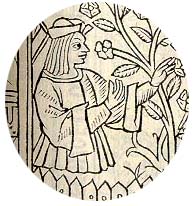
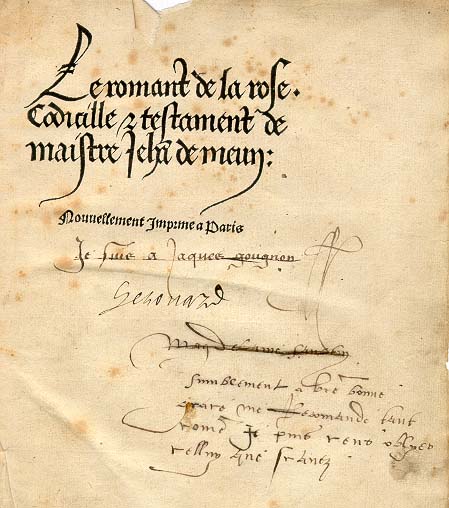 Title-Page, with ownership annotations |
One of the most popular works of medieval
French literature, Le Roman de la Rose survives today in some 300
manuscripts dating from the late 13th to early 16th century, and in numerous
printed editions from the 15th and 16th centuries. Widely read throughout
Europe, the poem influenced much of the literary output of the Middle Ages
and was enjoyed by poets such as Chaucer, Gower, Dante and Petrarch,
Begun in c.1225-40 and completed by c.1270-7, the poem is an allegorical dream vision about love, in which a young man endeavours to possess the rosebud with which he has become enamoured. The text is attributed to two authors, its first 4,058 lines being the work of Guillaume de Lorris, and the remaining 18,000 lines composed by Jean de Meun, an early 14th century Parisian writer and intellectual. Written in Middle French in octosyllabic rhyming couplets, the poem is important for being the first example in French of both a sustained first-person narrative and of narrative allegory. |
| Possibly France's most important vernacular
poem of the Middle Ages, by the end of the 14th century it had also been
translated into Italian, Dutch and English. The Middle English version, of
which the first 1,705 lines were translated by Chaucer, covers all of
Guillaume's section and some 3,000 lines of the second part. The original
poem can be said to be the most important single literary influence on
Chaucer's writings. Nothing is known about the writer of the first part of the poem, Guillaume de Lorris. His charming and lyrical section relates the story of the narrator's dream; it is a work of courtly love that has been praised for its perceptiveness in the expression of character through allegorical symbols. Set in the allegorical Garden of Delight (representing courtly society), the dreamer meets the god of love, and consequently falls in love with a rosebud that he sees while gazing into the fountain of Narcissus. The lover experiences a succession of hopes and despairs, but although he eventually manages to kiss the rose, his love is never truly consummated: his efforts are thwarted after Jealousy constructs a fortified tower around the rose. It is possibly at this point that the poem was meant to end. |
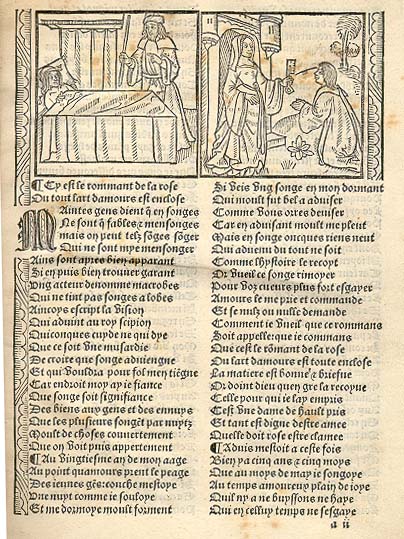 Opening Page: folio A2r |
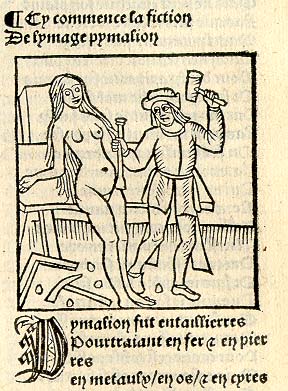 Woodcut of Pygmalion |
Jean de Meun continues the dream allegory
but completely transforms the poem, expanding it to become a satire of
contemporary society. In a thinly disguised allegory of sexual intercourse,
his lover finally penetrates the inner sanctum of the rose and the poem ends
with the narrator awakening at daybreak. Jean uses this plot as a means of
conveying a mass of encyclopaedic information, discussing such diverse
topics as language and signification, fortune and destiny, in a series of
discourses by the main characters. Thus the poem becomes a vast store of
information about medieval life and thought.
It has been estimated that more than forty other literary works are incorporated into this second part; in particular, the authors Ovid (for example, the story of Pygmalion from the Metamorphoses), Boethius, Alan of Lille and Guillaume de Sainte-Amour are drawn upon heavily. Although it was standard medieval practise to use material from a variety of other sources, this part of the poem has subsequently been criticised as a hodge-podge designed simply to show off the author's erudition. However, Jean's digressions in fact brought fame and success to the poem: often outspoken and apparently fearless in attacking the abuses of his age, the contentious opinions expressed here were hotly contested by contemporaries and captured the imagination of the increasingly important bourgeois class. |
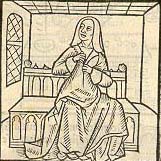 Woodcut (folio A3r) |
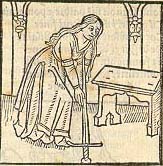 Woodcut (folio A3r) |
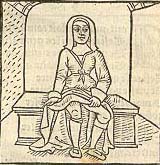 Woodcut (folio A3r) |
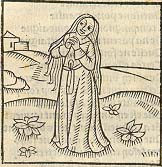 Woodcut (folio A4v) |
| This edition of Le Roman de la Rose was published by Antoine Vérard (fl. 1485-1512); although undated, it was probably printed in around 1505 in Paris. Vérard's name does not appear on the title-page but the device bearing his motto (Pour provocquer, Jhesus, ta grant misericorde/ De tous pecheurs faire grace et pardon, / Anthoine Verad humblement te recorde / Ce qu'il a il tďent de toi par don) is found at the end of the poem before the second work in the volume, the Codicille et Testament de Maistre Jehan de Meun. Vérard published extensively in French and is especially noted for his Books of Hours of which he issued some two hundred editions, with special illuminated copies for royalty printed on vellum. Fine woodcuts adorn many of his productions, and the early development of the illustrated book in France owes much to his prolific publishing output. |
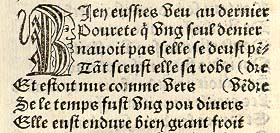 Initial letter (folio A5v) |
Vérard, however, has often been criticised for his re-use of blocks in book after book, as well as his repetition of illustrations in the same book, often in incongruous and highly inappropriate places. This edition of the Roman includes 88 cuts in a peculiar style; while a small number of the cuts are repeated, and some also appear in other publications by Vérard, they were evidently designed specifically for this text, and seem to have been closely imitating the cuts from an earlier edition of the poem, published by Du Pré in Paris in 1494. The decorative initials found in this volume are another typical feature of Vérard's productions; he had several sets of initials at his disposal, including a set of grotesque heads as used in this book. |
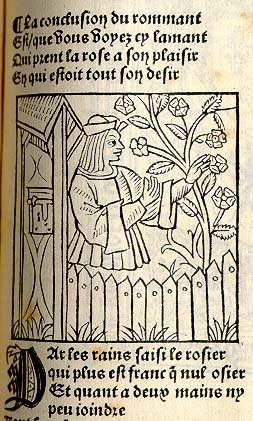 Conclusion |
Much of the appeal of the Roman
lies in the tantalising question of its allegorical meaning. Both poets
promise to explain the meaning of the dream, but do not: the poem has
consequently been subject to widely varying interpretations ever since it
was written. These divergent readings are divided mainly between those who
see the work as religious versus those who see it as secular. Christine de
Pizan was so provoked by the subject matter of the poem that she famously
initiated the 'Querelle de la Rose' in the fifteenth century; she attacked
the poem for defaming women, for justifying seduction and rape, and for
bawdy language. Such debate established the cultural importance of the
Roman as a focal point for many fundamental issues, and it remained
popular throughout the sixteenth century. Although the poem fell into
obscurity in the seventeenth century, it was rescued by the antiquarians of
the eighteenth century and is now firmly established as a literary monument,
still subject to constant revision and re-interpretation.
|
Other items of interestManuscripts Roman de la Rose
Fifteenth century manuscript in French:
MS Hunter 52
(T.2.10); The Romaunt of the Rose Unique fifteenth century manuscript
of Chaucer's version of the poem:
MS Hunter 409
(V.3.7) Return to main Special Collections Exhibition Page Julie Coleman February 2000
|